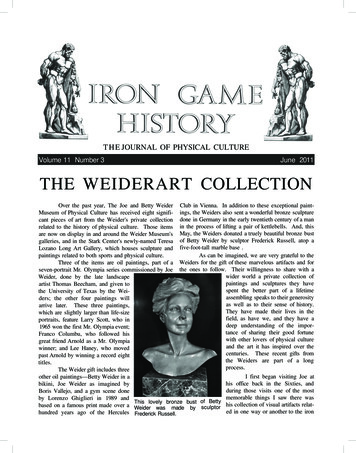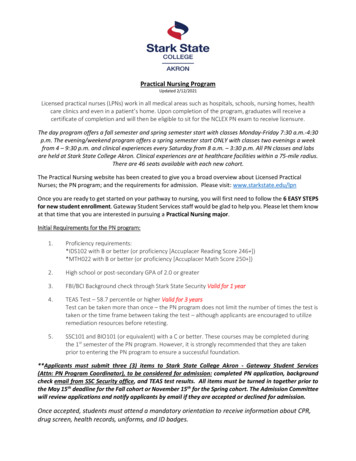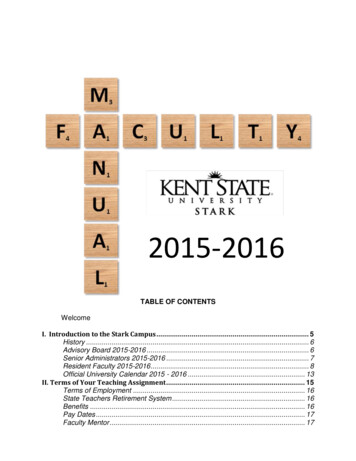
Transcription
T H E JOURNAL OF PHYSICAL CULTUREVolume 11 Number 3June 2011THE WEIDERART COLLECTIONOver the past year, The Joe and Betty Weider Club in Vienna. In addition to these exceptional paintMuseum of Physical Culture has received eight signifi- ings, the Weiders also sent a wonderful bronze sculpturecant pieces of art from the Weider's private collection done in Germany in the early twentieth century of a manrelated to the history of physical culture. Those items in the process of lifting a pair of kettlebells. And, thisare now on display in and around the Weider Museum's May, the Weiders donated a truely beautiful bronze bustgalleries, and in the Stark Center's newly-named Teresa of Betty Weider by sculptor Frederick Russell, atop aLozano Long Art Gallery, which houses sculpture and five-foot-tall marble base .As can be imagined, we are very grateful to thepaintings related to both sports and physical culture.Three of the items are oil paintings, part of a Weiders for the gift of these marvelous artifacts and forseven-portrait Mr. Olympia series commissioned by Joe the ones to follow. Their willingness to share with awider world a private collection ofWeider, done by the late landscapepaintings and sculptures they haveartist Thomas Beecham, and given tospent the better part of a lifetimethe University of Texas by the Weiassembling speaks to their generosityders; the other four paintings willas well as to their sense of history.arrive later. These three paintings,Theyhave made their lives in thewhich are slightly larger than life-sizefield, as have we, and they have aportraits, feature Larry Scott, who indeep understanding of the impor1965 won the first Mr. Olympia event;tanceof sharing their good fortuneFranco Columbu, who followed hiswithotherlovers of physical culturegreat friend Arnold as a Mr. Olympiaand the art it has inspired over thewinner; and Lee Haney, who movedcenturies. These recent gifts frompast Arnold by winning a record eighttheWeiders are part of a longtitles.process.The Weider gift includes threeI first began visiting Joe atother oil paintings—Betty Weider in ahis office back in the Sixties, andbikini, Joe Weider as imagined byduring those visits one of the mostBoris Vallejo, and a gym scene donememorable things I saw there wasby Lorenzo Ghiglieri in 1989 andThis lovely bronze bust of Bettybased on a famous print made over a Weider was made by sculptor his collection of visual artifacts related in one way or another to the ironhundred years ago of the Hercules Frederick Russell.
Iron Game Historygame. In the very early days, the "art" in question wasusually photographic art—photos of human bodieseither posed or in action that had somehow caught Joe'seye. Then, as now, Joe's "eye" is uncommonly perceptive, and many people have argued that his ability to"see" the difference between a good and a great photograph contributed significantly to his long success in themagazine business.As the years passed and Joe had a bit more discretionary income, he began to collect and even commission paintings and sculptures that reflected his particular visual tastes. This collection has grown andexpanded for decades and is one of the finest and mostextensive in the world of strength sports. Almost twen-Volume 11 Number 3ty years ago, I played a role in his acquisition of a smallpainting of Sig Klein as Mercury, done by C. BosseronChambers in 1926. (See the editorial in Volume 4, Number 1 of Iron Game History) The painting had beeninherited by Sig's family after his death and they hadconsigned it to Sotheby's for auction. Lacking the fundsto participate in such a high octane auction and fearingthat if I did take part my heart might write a check mybank couldn't cash, I contacted Joe in hopes that hemight wish to acquire it for his own collection. I knewthat he and Klein had been friends and that Joe had oftenvisited Sig during the years Joe's home offices were inNew Jersey not all that far from Sig's famous Manhattangymnasium.
Iron Game HistoryVolume 11 Number 3I r o n Game H i s t o r yTHE JOURNAL OF PHYSICAL CULTUREVol. 11 No. 3 June 2011Table of Contentsl.Weider Art CollectionTerry Todd4. Boyd EpleyJason Shurley & Jan Todd14. Jim LorimerKat Richter & Jan Todd33. Review: Legends of the Iron GameJohnFairCo-EditorsAssociate Editor.Assistant EditorJan & Terry ToddKim BeckwithThomas HuntEditorial Board: John Balik (Santa Monica, CA), JackBerryman (Univ. of Washington, Seattle), David Chapman (Seattle, WA), John Fair (Georgia College & University, Milledgeville, GA), Charles Kupfer (Penn State, Harrisburg.), Grover Porter(Univ. of Alabama, Huntsville), Joe Roark (St. Joseph, IL), and David Webster (Irvine,Scotland).Iron Game History is published by the McLean Sports History Fellowshipat the University of Texas at Austin, under the auspices of The H.J.LUTCHER. STARK CENTER FOR PHYSICAL CULTURE & SPORTS, U.S.subscription rate: 25.00 per four issues, 40.00 per eight issues. McLeanFellowship subscriptions 60.00 per eight issues; Patron subscriptions 100.00 per eight issues. Canada & overseas subscriptions: 30.00 per fourissues and 45.00 per eight issues. U.S. funds only. See page 36 for furtherdetails.Address all correspondence and subscription requests to:Iron Game History, The H.J. Lutcher Stark Center for Physical Culture &Sports, NEZ 5.700, D3600, The University of Texas, Austin, Texas, 78712.For back issues or subscription queries, please contact Associate EditorKim Beckwith at: kim@starkcenter.org. Phone: 512-471-4890Back issues may be also ordered via our website:www.starkcenter.org/research/igli/Jan Todd's email: jan@starkcenter.orgTerry Todd's email: terry@starkcenter.orgIron Game History is a non-profit enterprise.Postmaster: Send address corrections to: IGH, NEZ 5.700, D3600, University of Texas, Austin, Texas 78712.(ISSN 1069-7276)Patron SubscribersMike AdolphsonJohn BalikRegis BeckerLaszlo BenczeChuck BurdickJerry ByrdDean CamenaresGary CamilloBill ClarkKevin CollingsRobert ConciatoriLucio DoncelDave DraperJohn FigarelliSalvatore FranchinoPeter GeorgeDavid HartnettJohn V. HigginsDale JenkinsRobert KennedyRay KnechtNorman KomichWalter KrollJack LanoRed LerilleGeorge LockLeslie LongshoreAnthony LukinJames LorimerDon McEachrenLou MezzanoteDavid MillsBen MitchamJames MurrayGraham NobleBen OldhamVal PasquaRick PerkinsGrover PorterTom ProchazkaBarnet PugachTerry RobinsonDennis RogersJim SandersFrederick SchutzRev. Jim SchwertleyBert SorinRichard SorinHarold ThomasFrancis X. TirelliTed ThompsonTom TownsendStephen R. TurnerDavid P. WebsterJoe & Betty WeiderKim & John WoodIn Memory of:Joe AssiratiSteve ReevesChuck SipesLes & Pudgy StocktonDr. Al ThomasBob BednarskiFellowship SubscribersBob BaconGeorge BangertAlfred C. BernerMike BonDurantLewis BowlingJim BrownJohn CorlettJohn CrainerWilliam DeSimoneAlton EliasonJudy GedneyDon GrahamHoward HavenerDykes HewettJack HughesDaniel KostkaThomas LeePatrick J.LuskinJohn MakarewichPaul ManocchioRobert McNallRichard MiglioreGeorge MillerRay MillerTony MoskowitzH. MovagharBill NicholsonJohn F. O'NeillKevin O'RourkeDavid PeltoEarl RileyKen "Leo" RosaJohn T. RyanPete RyanRobert. SchreiberDavid B. SmallEdward SweeneyDonald SwingleDr. Victor TejadaLou TortorelliMichael WallerTed WarrenDan WathenReuben Weaver
June 2011Iron Game HistoryAs it happened, Joe was very interested, so heout-bid everyone else and acquired the painting—whichoddly enough had no reference to the fact that the model was Klein. Several years later, on a trip to the WestCoast I visited Joe at his office in Woodland Hills and, asI was leaving, he took me to one of the rooms in hisoffice complex and showed me the painting, which I'dnever seen. It was very beautiful, and as I was praisingit he told me that since I liked it and had helped him getit he wanted me to take it back to Texas and add it to ourcollection. For me, the gift was absolutely unexpected,as it perhaps was even by Joe, but it signaled his growing understanding of the responsibility which came withhis enormous success in the field. In the years since thattime Joe has given us substantial sums of money to helpus with our work and to help us honor the pioneers in thefield we love. Without that financial support we mightIn 1989, Joe Weider commissioned Lorenzo Ghiglieri toproduce this oil version of a print depicting a training session in a Viennese weightlifting club/beer hall. Closeobservers will see on the wall a picture of Hans Steyer, theBavarian Hercules. The Warren Lincoln Travis Dumbbellon the floor below weighs 1560 pounds.This bronze statue shows a man lifting kettlebells, whichwere in common use one hundred years ago. By 1950 kettlebells were only rarely seen in the U.S. but they haverecently made a remarkable comeback, particularlyamong athletes.not have been able to get this library-museum project offthe ground. Even so, as unendingly grateful as we arefor the funding we have received from the Weider Foundation, the gift by Joe and Betty of their personal art collection seems to us to be even more meaningful. Eachtime I pass through our lobby areas and our Art Galleryand see the large portrait of Franco Columbu or the smallpainting of Sig Klein or the splendid bronze statue of aman lifting kettlebells I think of Joe and Betty and feelindebted to them for placing their very private collectionin our very public space. I never tire of showing thesethings to visitors and I never tire of reminding those visitors that none of the art would be here were it not for theWeiders, who personify the truth of the old Jewishproverb,"If charity cost nothing the world wouldbe full of philanthropists. "—Terry Todd
11-3 all B&W IGH Final Layout--to PDF:IGH Vol 9 (1) July 2005 final to Speedy.qxd 8/2/2011 5:55 PM Page 4Iron Game HistoryVolume 11 Number 3“if anyone Gets slower, you’re fired”:Boyd epley and the formation of the strengthcoaching ProfessionJason shurleyconcordia university Texas&Jan ToddThe university of Texas at austinIn a 1960 article in Strength & Health magazine, Al Roy, the man dubbed “the first modern strengthcoach,” was asked about his legacy.1 “In his typicaladroit manner,” the article’s author explained, “the manresponsible for this genesis in training recalls those whoinspired him. He acknowledges the fact that the selfstyled father of American weightlifting, Bob Hoffman,and the weightlifting technician, John Terpak, laid thefoundation for his own system and are exemplars forthose who will follow. “And others will follow,” theauthor continued, “for he [Roy] emphatically states thatthe surface has just been scratched in creating a need forvital young men in the field of developing strength forathletics.”2 These words proved prophetic, as the Sixtieswould close with the hiring of Boyd Epley, a young manwho would eventually mold strength coaching into theautonomous profession we recognize today.Strength training for athletics underwent a cultural and pedagogical shift in the United States in the1950s and 1960s. Prior to that time, most athletes avoided weight training because they had been warned bycoaches, doctors, or sports scientists that weight trainingwould make a person “muscle-bound.”3 By the 1960s,however, a few individual athletes had begun to understand that strength training increased speed and explosiveness and so trained on their own, often far from thewatchful eyes of their coaches. By the end of the 1970s,however, it was much less likely for an athlete to compete for a championship in any sport without havingspent the requisite time in the weight room doing sportspecific conditioning drills. So pervasive had preparation for sports become that, in 1978, Nebraska StrengthCoach Boyd Epley was able to convince others to joinhim and form the National Strength Coaches Associa-tion, now known as the National Strength and Conditioning Association (NSCA).4 The paradigm shift froman athletic world with only a few isolated barbell men,to a professional organization of strength coaches withnational reach happened suddenly, and the reason forthat shift is best encapsulated in five words: Boyd Epleyand Husker Power.Less than a decade earlier, in September of1969, Epley, a junior pole-vaulter at the University ofNebraska, was performing his daily rehabilitation exercises in the tiny Schulte Field House “weight room”when he was summoned by an assistant athletic trainerand told, “You’ve got a phone call.” Epley was surprised to be receiving a call; he’d been a student-athleteat Nebraska for less than a year and he certainly didn’texpect to get a call at the athletic complex. His contemplation of who might be on the line was interrupted bythe athletic trainer, who impatiently shouted, “Get inhere! It’s Tom Osborne.” Osborne, who would laterbecome the most successful head football coach inNebraska history, was at that time coaching the receiversand calling the offensive plays for the team. Epleyrecalls that he was taken aback when he heard it wasOsborne, and wondered if he’d somehow gotten intotrouble with the coaching staff.5First, some background. As part of Epley’srehabilitation program for a back injury, he had chosento include heavy resistance training. While the meagerselection of weights and machines in Schulte FieldHouse made serious weight training somewhat difficult,Epley drew upon his previous exposure to bodybuildingand Olympic weightlifting to craft a program to improvehis overall strength while he was recovering from histraining injury. Other injured athletes, also unable to4
11-3 all B&W IGH Final Layout--to PDF:IGH Vol 9 (1) July 2005 final to Speedy.qxd 8/2/2011 5:55 PM Page 5June 2011Iron Game Historyhow to lift weights?” Somewhat reluctantly, Epleyaffirmed that he had been working with the players andthat some of them had been following his routine. Then,to his surprise, Osborne said, “I’ve noticed that theycome back to practice healthier and stronger and I’minterested to know what you’re doing in there. Wouldyou be interested in coming over and talking to me?”6Epley, with a sigh of relief, said he’d be happy to comeright over.7Osborne and the other Nebraska football coaches had no doubt seen the well-muscled, 180-pound Epleyaround the athletic complex, but they could not haveknown that along with his athleticism and exceptionalmuscular development, Epley was already a serious student of strength and conditioning practices. In fact, bythe time he arrived at Nebraska, he was familiar with thetraining methods of bodybuilding, powerlifting, andOlympic weightlifting and had learned to borrow fromall three systems for his own training.Boyd’s involvement with strength trainingbegan in the seventh grade when his father purchased aYork barbell set for him. That set included a sheet ofinstructions on how to perform the Olympic lifts and soyoung Boyd began his career by doing presses, snatches,cleans, and jerks. Although he practiced these lifts faithfully for a time, he gradually lost interest in training athome. When he entered Alhambra High School inPhoenix, Arizona, Epley tried barbell training again, thistime as part of a physical education class. Again, however, he didn’t stick with it. According to Epley, it just“didn’t really make sense” to him at that time. However, following the end of the football season in his junioryear in high school he decided he had to be bigger andstronger and so he began training more seriously in orderto gain weight.8 During the summer between his juniorand senior years he worked out at a local health clubwith a classmate, Pat Neve, who would go on to winmultiple powerlifting competitions and the Mr. USAbodybuilding title in 1974.9 Neve, who was alreadyinterested in bodybuilding, taught Epley how to train,and by the end of the summer Boyd had gone from 160pounds to 180 and had learned a great deal about thetraining methods of bodybuilders and powerlifters.When he reported for football practice in the fall hisnewly added size was, “kind of a shocker to my coaches.”10 At linebacker, Boyd went from a self-described“non-factor” his junior year to the defensive player ofAlthough Epley played football in high school in Phoenix,Arizona, his great love was pole valuting and he was givena scholarship to the University of Nebraska after twoyears on the track team at Phoenix College. At Nebraskahe set a new indoor school record at fifteen feet during hisjunior year but then suffered a back injury that ended histrack career.practice, were frequently in the weight room duringEpley’s workouts and a number of them became sointrigued by his training program that they began following him around and performing the same exercises.At the time, none of the Nebraska athletic teams engagedin organized, heavy resistance training. The prevailingbelief at Nebraska in this era, according to Epley, was nodifferent than that in many other athletic circles acrossAmerica—i.e., athletes should not do heavy weighttraining because it would result in slower athletes with adecreased range of motion. Consequently, heavy resistance training was excluded from nearly all sport-trainingprograms. So, as he walked to pick up the telephonereceiver, Epley worried that Osborne’s call would be arebuke for allowing some of the injured football playersto lift with him. And, at first, his heart sank as Osborneasked, “Are you the guy who’s been showing these guys5
11-3 all B&W IGH Final Layout--to PDF:IGH Vol 9 (1) July 2005 final to Speedy.qxd 8/2/2011 5:55 PM Page 6Iron Game HistoryVolume 11 Number 3the year as a senior. His newfoundwasn’t sure how much Osbornestrength also translated well to hisintended to spend on the nascentspring sport, track, where he garprogram. To train the entire team henered track athlete of the year honorsasked for only two squat racks, baras a pole vaulter. After graduation,bell plates and racks to hold them,he took a track scholarship to attendone bench, a light pulley system forPhoenix College, the local juniorshoulder work, dumbbells in pairscollege. There, he continued liftingfrom five to one hundred pounds, aand soon caught the eye of thepreacher curl bench and weights,Nebraska track coach Dean Brittentwo free-standing benches, twoham who, in 1968, offered Epley aincline benches, and three Olympicscholarship to join the track team atbars to go with the small amount ofthe University of Nebraska. EpleyequipmentNebraskaalreadyset a new Nebraska record in theowned.12 According to Epley,Osborne took the list from him,indoor pole vault at fifteen feet butgave it only the most cursory glancethen, during his preparation for theand handed it to the football secrespring 1969 track season, he sufferedtary, instructing her to “order this.”the back injury that inadvertently putEpley later claimed that thathim on the path to shaping the futuremoment opened his eyes to the powof Nebraska athletics and creatingthe profession of strength coaching. Although a back injury stopped him er of football on campus, and so heOne can only imagine what from competing in the pole vault, Epley shrewdly said, “Coach! I forgot themust have been going through continued to lift weights and began second page,” feigning distress.Epley’s undergraduate mind as he competing in powerlifting and body- Epley recalls that Osborne thenabandoned his workout and walked building competitions. This photo, gave him a wry smile and said,taken in 1971, shows him at a body“Alright, bring me the second pageto Osborne’s office following the weight of approximately 180 pounds.tomorrow.”13phone call. To Epley’s great surOsborne then turned to Epley and told him,prise, however, when he got there Osborne didn’t wantto just talk; he had a proposition for Epley. Osborne told “Now we’ve got to go in and see Bob.” The commentEpley that he was interested in having the entire Corn- jolted Epley. Bob Devaney was Nebraska’s head foothusker football team begin a weight lifting program and ball coach and athletic director and therefore one of thehe asked what Epley would need in order to direct such most powerful men in the state of Nebraska. “What doyou mean?” Epley asked incredulously. Osbornea program.Epley’s response to that question tells a lot about responded, “We’ve got to go get permission to do whatthe man he eventually became. Rather than just sug- we just did.” And with that the men headed up togesting that he could get by with only a few extra Devaney’s office. Epley recalls how unnerved he was toweights, Epley informed Osborne that the current weight see Devaney sitting behind his massive desk in anroom was too small to accommodate an entire team’s imposing red leather chair and claims he has a hard timeworkout and that a significant amount of additional remembering all he said to convince Devaney to supportequipment would be needed. After talking about space Osborne’s project.14 While Devaney was interested inand what equipment would need to be ordered, Osborne the idea he was not at all sold on it. “Why,” he wanteddecided to place his faith in the self-assured twenty-two to know, “should we [lift weights]? No one else is doingyear-old and told him he’d have a wall moved to create it. My good friend Duffy Daugherty at Michigan Statea larger space. Osborne then asked Epley to write out a isn’t doing it. Why should we?”15 The only real evishopping list of new equipment that they’d need for dence Epley was aware of for the efficacy of a strengthprogram was anecdotal, in the form of his own successtraining the entire team.11Epley returned the next day with a list of the through strength training. He groped for an answer andbasic equipment needed for such a program. The initial eventually informed Devaney that weight training wouldlist was fairly conservative owing to the fact that Epley help him win more games because his players would be6
11-3 all B&W IGH Final Layout--to PDF:IGH Vol 9 (1) July 2005 final to Speedy.qxd 8/2/2011 5:55 PM Page 7June 2011Iron Game Historyfaster. With that Devaney toldOsborne and Epley that they couldgo ahead, but then looking Epleysquare in the eye he told him, “Ifanyone gets slower, you’re fired.”16Epley’s career as a strength coachhad formally begun.TheundercurrentinDevaney’s apprehension that liftingheavy weights would decrease hisplayers’ speed was, of course, thenotion that his athletes wouldbecome “muscle-bound.” The ideaof a “muscle-bound” athlete was aconcept that defied physiologicaldefinition and existed because ofinference and anecdotal evidence.17The widely-held belief was thatheavy training would limit a joint’srange of motion and result indecreased speed of muscle contractions.18 Author and former Strength& Health editor, Jim Murrayexplains, “From everyday experience, we know that body bulk in animals and men does not accompanyspeed and flexibility. A bulky drafthorse will lose out to a race horseany day, and a circus contortionist,that miracle of flexibility, never hasthe body of Hercules.”19 When wethink of those with tremendousstrength, we tend to think of individuals who would fall into the heavyweight classes in competitive lifting. As the head strength coach at Nebraska, Epley played an active role on the fieldIn fact, Benjamin Massey credits as well as in the weight room. In this photo he helps defensive end Neil Smithstrongmen with contributing to the stretch his hamstrings before a game. Smith was an All American at Nebraskanotion of the muscle-bound lifter: in 1987 and then had an eleven-year career in the NFL, making the Pro Bowl sixtimes.“Many of them were ponderous menperforming their feats by brute strength. Skill was not believes “People are victims of their coaches. Whatimportant. It was only natural that the public should their coaches did to them is what they know; whether it’sassociate ponderosity (sic) and awkwardness with right or wrong.”22 Given that Bob Devaney played hisweight lifting.”20 Once the idea of becoming “muscle- collegiate football in the 1930s, it seems quite likely thatbound” became entrenched in the minds of coaches, ath- his approach to preparation for football was guided byletes, and educators, it had a snowball-like effect. Those what his coaches “did to him,” which almost certainlywho believed it to be true passed on the idea to their did not include participation in or advocacy of weightcharges who, hearing the idea from a person whom they training.23In addition to the myth of muscle-binding hamassumed to be a reliable source, took it as fact.21 In anperingtheapplication of weight lifting to sports, anothinterview with Terry Todd, Epley commented that he7
11-3 all B&W IGH Final Layout--to PDF:IGH Vol 9 (1) July 2005 final to Speedy.qxd 8/2/2011 5:55 PM Page 8Iron Game HistoryVolume 11 Number 3er dying paradigm was slowing theplayed in the Rose Bowl, once tolddevelopment of conditioning for athus, ‘I don’t want any muscleboundletics—the notion that athletic abilityweightlifters on my team.’” Paschallwas a fixed trait. Historian Johngoes on to say, “The coach is noHoberman cites an American physilonger with this University because,cian of the late nineteenth century aswhile he was a smart strategist andclaiming, “This limit [of strength andknew football, he didn’t know menspeed] is fixed at different points inand didn’t know proper methods ofeach man in regard to his variousconditioning. He belonged in thepowers but there is a limit beyondPast and that is where he is nowwhich you cannot go in any direcspending his future.”26 The idea thatlifting heavy weights would result intion.” Hoberman goes on to say,decreased athletic performance seems“This limit, in turn, was nothing lessalmost laughable now, but that’sthan ‘a law of Nature.’ Indeed, thelargely because Boyd Epley and hislast decades of the nineteenth centunew program at Nebraska would gory saw an important struggle betweenHead football coach Bob Devaney’sthese two opposed theories of human concern that strength training might on to play an important role in dispotential: an older doctrine of natural make his team slower inspired Epley pelling the myth of muscle-binding.In the fall of 1969, Boblimits and a new doctrine of expand- to begin testing his players and toing biological limits. The new exper- keep meticulous records. As Devaney Devaney was in danger of similarlyimental approach to high-perform- soon learned, Epley’s program made belonging to the past. He’d come tothe players faster and stronger andance athletics was one expression of unquestionably helped them win the Nebraska in 1962 and, in his first fivethe expansive interpretation of National Championships in 1970 and seasons, finished no worse than 9-2.By the late sixties, however, hishuman capacities.”24 Rob Beamish 1971.and Ian Ritchie assert that this belief in natural limits teams had fallen off of the standard that he had helpedwas manifested in preparation for sport in that, “The set, going 6-4 in both the ’67 and ’68 seasons and failingterm ‘training’ existed in the late nineteenth and early to reach a post-season bowl game.27 Making matterstwentieth century and coaches and athletes approached it worse, the Huskers finished the 1968 season by taking awithin the premises of the first law [of thermodynam- 47-0 thrashing at the hands of their arch-rival, the Oklaics].Training was synonymous with ‘drill’—the repeti- homa Sooners, on national television. At this point,tion of skills to refine technique, improve coordination, some of the donors and alumni had begun grumbling thatand enhance precision and execution. Training was not it might be time for a coaching change. Nebraska fans indesigned to systematically increase physical power, Omaha went so far as to start a petition calling forspeed, endurance, and agility through specific, targeted Devaney’s removal.28 Faced with this reality, Devaneyprogrammes.”25 If a coach is operating under the knew that changes had to be made, thus providing theassumption that, due to natural law, his players are as impetus for what later became Husker Power.While Devaney may have believed that no otherstrong and fast as they were “born” to be, it would notoccur to him to spend time trying to enhance their per- teams were training with weights, however, quite a fewformance by trying to build their strength or increase were. In spite of Devaney’s trepidation, he was not thetheir speed either during or outside the playing season. first coach who’d been goaded into the addition of aAgain, given the era during which Devaney was himself strength training program, though he was perhapsa student and the prevailing theories that were taught to unaware of this. Those coaches too were leery, but theirhis coaches, it is quite possible that he’d spent the major- gambit paid off beyond their wildest expectations. Byity of his career operating under at least some form of that time, Bob Hoffman, founder of the York BarbellCompany and coach of the USA Weightlifting team, hadthis “paradigm of natural athletic ability.”The attitude of many coaches, who thought like been battling ardently against the myth of muscle-bindDevaney did at that time, was epitomized by Harry ing for several decades. Through his magazine, StrengthPaschall in a 1956 issue of Strength & Health magazine: & Health, he and his disciples at the magazine published“One Midwestern University Coach, whose teams have volumes extolling the virtues of weight training for ath8
11-3 all B&W IGH Final Layout--to PDF:IGH Vol 9 (1) July 2005 final to Speedy.qxd 8/2/2011 5:55 PM Page 9June 2011Iron Game Historyletes, and Hoffman even went so far as to offer five thousand dollars to anyone who could produce a man whobecame muscle-bound through the use of weights.29 Inspite of his conviction, Hoffman was initially unable toconvince many coaches that weight training wouldn’timpede their players’ athletic ability. Perhaps part of thereason for this is that while Hoffman was correct aboutsome of the benefits of weight training, he also oftenextolled virtues which
painting of Sig Klein as Mercury, done by C. Bosseron Chambers in 1926. (See the editorial in Volume 4, Num-ber 1 of Iron Game History) The painting had been inherited by Sig's family after his death and they had consigned it to Sotheby's for auction. Lacking the funds










